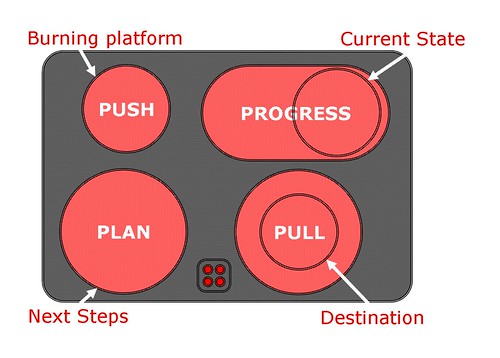By now you must know that I am a firm believer and a copycat of successful marketing concepts. The ‘marketing mix’ of Philip Kotler is one of those basics I keep referring to.
Remember what the 4 P’s of marketing are? (they are: Place, Product, Promotion and Price) Well, in organizational change management, there is also a mix that applies. And it equally contains 4 P’s…
The Marketing Mix of Organizational Change
The 4 P’s of Organizational Change are not a plain copy of the marketing mix as the context is not one of consumers with a buying potential but one of employees with an attention potential. The idea comes from Bill Jensen as he builds a case for simplicity.
According to him it is essential to formulate the need for change as clear and simple as possible, because people tolerate management’s logic but still they will draw their own conclusions. As a result you need to practice what he calls ‘behavioral communication’; i.e.: communicating on the level of the information needs of the receiver (as opposed to: ‘the justification needs of the sender’).
Cooking Class
In my trainings I often compare an organizational change effort with the chemistry that is involved in cooking. Even though the comparison with cooking may not seem so obvious, it’s worth noting that the chemistry of cooking involves molecules of different ingredients to be blended through heating into a new form: a prepared meal.
The same goes for organizational change: heating up existing ingredients, occasionally adding some elements and blending them into a new shape with a new objective. In this perspective the 4 P’s are the boiler plates that you need in order to create the exact heat that is needed for the chemistry to happen.

Ok now, back to the 4 P’s of Organizational Change; what are they and do I have a simple trick to remember them?
Well, just as a good cook knows his way around the kitchen and knows how to handle the kitchen equipment, a compelling case for change is always built up along the lines of these 4 boiler plates:
- PUSH: people will only take the leap into the unknown if their house is on fire. That is why the first step always serves to indicate that there is no other option than change.
- PROGRESS: the answer to the question: ‘where are we and what have we accomplished to date?’, which clearly indicates which certainties and means are at our disposal to undertake this process of change.
- PLAN: a clarification of the different steps ahead of us and actions that we need to undertake in order to reach the nearest milestone and the one after that and so on.
- PULL: the final destination, which serves as the magnetic North or the lodestar in case people would lose a sense of direction.
There is also a 5th P: getting all the information on one and the same Page!
The Daily Routine of Great Cooks
The point is that these 4 P’s are so essential that you should not keep them as a one-off exercise or a ‘nice brain teaser’ (this statement is usually followed by “and now back to work”). If you are serious about making a compelling case for change and weaving it into to your approach of managing your project then these 4 P’s should be shaping your status reporting at all levels.
If you want to become a good cook, it will take some practice and “failing forward”. Along the road you will discover how the heating equipment works and how to make best use of it: gas, electricity, induction, fire, grill,…In the language of Organizational Change Management: along the way you will find out what works best in your environment to heat up or cool down things in your organization. All the best in practicing the 4 P’s!



Pingback: Luc’s Thoughts on Organizational Change » E Qwè! – My Quest for Relevance ( #smc2010 congress )()